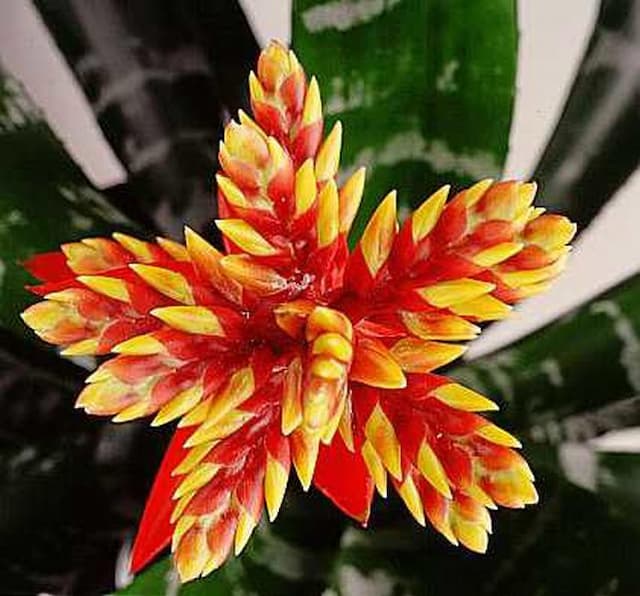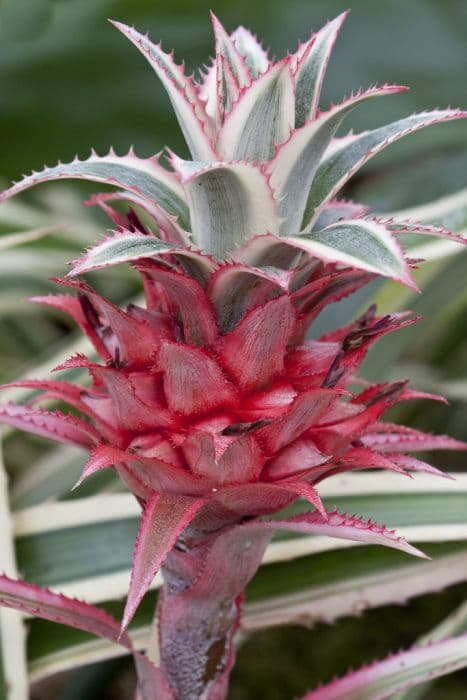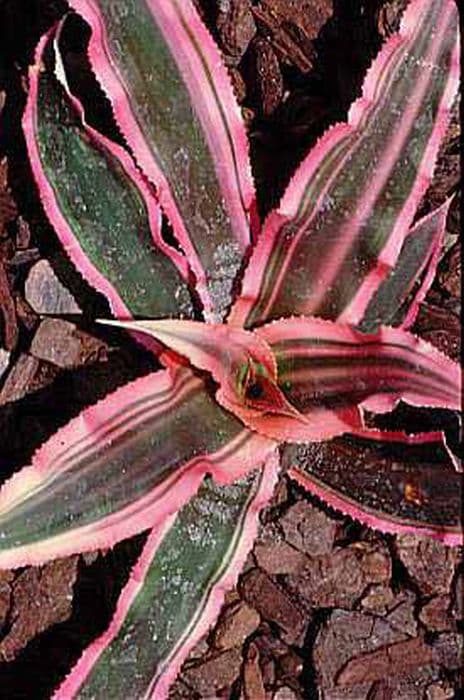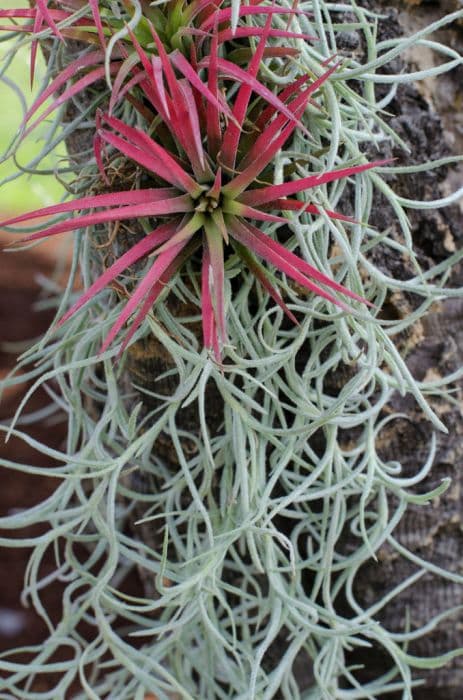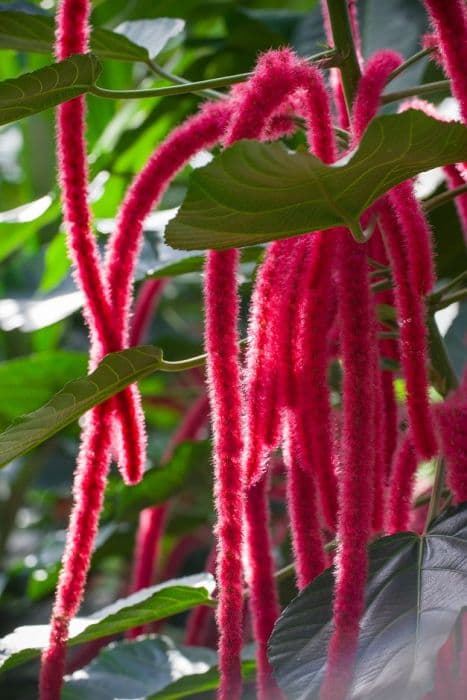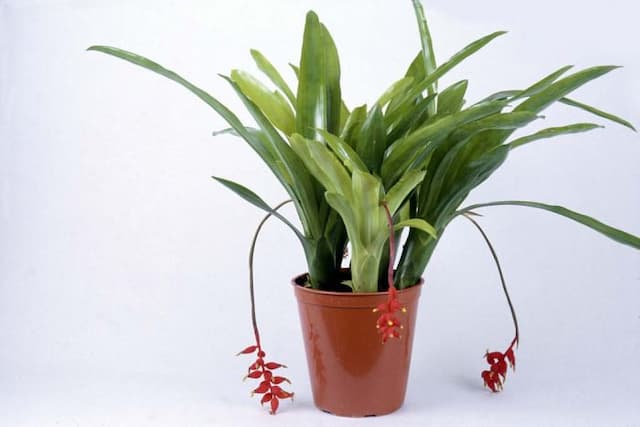Pineapple Ananas comosus (F)

ABOUT
A. comosus is a terrestrial bromeliad with dense rosettes of dark green, lance-shaped, evergreen leaves up to 1m long, with spiny margins. In summer it produces cone-like clusters of purple flowers, with reddish-yellow bracts, followed by bright red, edible pineapples up to 30cm long
About this plant
 Names
NamesFamily
Bromeliaceae
Benefits
 General Benefits
General BenefitsAnanas comosus, commonly known as the pineapple plant, offers several benefits, both nutritional and medicinal, which go beyond its use as a delicious fruit. Here's a list of general benefits: 1. **Rich in Vitamins and Minerals:** Pineapples are a good source of vitamins C and A, which are antioxidants that can help reduce the risk of chronic diseases. They also contain manganese, which is essential for bone health and metabolism. 2. **Dietary Fiber:** Pineapple is high in dietary fiber, which aids in digestion, promotes regularity, and can help lower cholesterol levels. 3. **Enzyme Bromelain:** This plant contains bromelain, an enzyme that can aid in the digestion of protein and reduce inflammation and swelling. It is often used in treating sports injuries and postoperative swelling. 4. **Immune Support:** The high levels of vitamin C in pineapples support the immune system, helping to protect against illness and infection. 5. **Anti-inflammatory Properties:** Bromelain's anti-inflammatory properties also make the pineapple an adjunctive therapy for conditions like arthritis and sinusitis. 6. **Cancer Prevention:** Some studies suggest that bromelain and other antioxidants in pineapples might have anti-cancer properties, although more research is required in this area. 7. **Eye Health:** Pineapples contain beta-carotene and vitamin A, beneficial for eye health and may reduce the risk of age-related macular degeneration. 8. **Heart Health:** The fiber, potassium, and vitamin C content in pineapple all support heart health. Potassium intake can help lower blood pressure and reduce the risk of stroke. 9. **Weight Management:** Pineapples are low in calories and high in water content, making them an excellent snack for those looking to manage their weight while still satisfying a sweet tooth. 10. **Potential Antimicrobial Properties:** Some studies indicate that pineapple extract may have antimicrobial properties, which could be beneficial against various pathogens. 11. **Wound Healing:** Bromelain may also assist in removing dead tissue from burns and aiding the healing process when applied topically. 12. **Anti-parasitic Effects:** Pineapple has been traditionally used in some cultures to combat intestinal worms and other parasites. 13. **Skin Health**: Because of its vitamin C content, which is vital for collagen synthesis, pineapples can contribute to healthier skin and could be used in the treatment of acne and other skin conditions. 14. **Boosts Fertility:** Nutrients in pineapple such as zinc, folate, and antioxidants have been linked to improved fertility in both men and women. It's important to note that while pineapple offers these health benefits, more research may be needed to substantiate some claims, especially in the dosage and efficacy when treating specific conditions. For individuals with specific health conditions or allergies (like bromelain sensitivity), it's always advisable to consult a healthcare professional before significantly changing dietary habits or using it therapeutically.
 Medical Properties
Medical PropertiesAnanas comosus, commonly known as the pineapple, has several potential health benefits and medicinal properties. Below is a list of some of these properties along with short explanations: 1. **Digestive Health**: Pineapple contains bromelain, an enzyme that helps in the digestion of proteins. Bromelain can reduce symptoms of indigestion and can act as a digestive aid. 2. **Anti-Inflammatory Effects**: Bromelain in pineapple has anti-inflammatory properties. It may help reduce inflammation in conditions such as acute sinusitis, sore throat, arthritis, and gout. 3. **Immune Support**: Pineapple is rich in vitamins, especially vitamin C, which is an antioxidant that can help strengthen the immune system. 4. **Wound Healing and Tissue Repair**: Bromelain may also have a beneficial effect on wound healing due to its anti-inflammatory properties and its role in fibrinolysis which involves the breakdown of blood clots and scar tissue. 5. **Antioxidant Capacity**: Pineapple contains various antioxidants, including vitamin C, beta-carotene, and various flavonoids that contribute to the neutralization of free radicals and may reduce oxidative stress. 6. **Supports Bone Health**: Pineapple has a moderate amount of manganese, a mineral that is important for the development of strong bones and connective tissue. 7. **Oral Health**: The vitamin C in pineapple can help prevent periodontal disease and gingivitis. It also contributes to maintaining healthy teeth and gums. 8. **Hydration**: Due to its high water content, consumption of pineapple can help in hydration which is important for healthy skin and overall bodily functions. 9. **Blood Pressure Regulation**: Pineapple fruit contains potassium which may help to ease tension in blood vessel walls, thus promoting proper blood pressure levels. 10. **Eye Health**: Antioxidants like vitamin C and beta-carotene in pineapple may contribute to eye health and reduce the risk of macular degeneration. 11. **Cardiovascular Health**: Pineapple's fiber, potassium, and antioxidants may support heart health by reducing the risk of atherosclerosis, lowering blood pressure, and improving lipid profiles. While pineapple and its components have numerous medicinal properties, it is always important to consume it in moderation due to its sugar content. Additionally, people with certain health conditions or allergies should consult with healthcare professionals before increasing their intake of pineapple or bromelain supplements.
 Air-purifying Qualities
Air-purifying QualitiesAnanas comosus, or more commonly known as pineapple, does not have notably unique air-purifying qualities in comparison to other houseplants. The idea that certain plants have strong air-purifying effects originates from a NASA study that investigated the ability of plants to remove volatile organic compounds (VOCs) from the air in closed environments. While this study and subsequent ones included various plants, Ananas comosus was not specifically noted for exceptional air-purifying capabilities. It's important to note that while plants can contribute to improved air quality through photosynthesis by absorbing carbon dioxide and releasing oxygen, the degree to which they remove other pollutants in typical home environments is subject to debate. Most household environments differ significantly from the controlled conditions of laboratory studies. To improve air quality, it is often more effective to address the source of pollution, ensure adequate ventilation, and, if necessary, use air purifiers with HEPA filters or other technologies designed to remove airborne contaminants. Plants, including Ananas comosus, contribute positively to indoor environments by enhancing humidity and general well-being, but they should not be relied upon as the primary method for air purification.
 Other Uses
Other Uses1. **Textile Production**: Fibers from Ananas comosus leaves can be extracted and processed to make a textile known as "piña," which is used in the Philippines to create traditional clothing such as the Barong Tagalog. 2. **Natural Sweetener**: The core of Ananas comosus, which is often discarded due to its toughness, can be used to produce a natural sweetener as it contains more concentrated sugars than the rest of the fruit. 3. **Plant Propagation**: The top crown of Ananas comosus can be replanted to grow a new pineapple plant, making it an example of vegetative propagation that can be easily achieved at home. 4. **Meat Tenderizer**: The juice of Ananas comosus contains an enzyme called bromelain, which can break down proteins. This characteristic makes it an ideal natural meat tenderizer for cooking. 5. **Alcohol Production**: Fermented Ananas comosus juice is used to produce a fruity wine or vinegar, which can be used for culinary or preservation purposes. 6. **Biodegradable Materials**: The strong fibers of Ananas comosus can be used in the creation of biodegradable materials such as eco-friendly packaging or disposable plates and utensils. 7. **Jewelry and Accessories**: Dried slices or parts of Ananas comosus are employed to create unique and fashionable jewelry items or decorative elements in accessories. 8. **Fruit Leather**: The pulp of Ananas comosus can be pureed and dried to create a chewy, sweet snack known as fruit leather, an alternative to candy and other sweet treats. 9. **Botanical Studies**: Because of its unique growth process and flower formation, Ananas comosus is sometimes used as a subject in botanical studies to understand plant development and morphology. 10. **Culinary Garnish**: Aside from being eaten, Ananas comosus can be creatively carved and used as an ornate garnish to add exotic flair to dishes and cocktails. 11. **Natural Scrubber**: The rough texture of the Ananas comosus skin can be utilized as a natural abrasive scrubber for cleaning dishes or scrubbing surfaces. Please note that while an enzymatic meat tenderizer function has direct implications for food preparation, which is commonly acknowledged, the inclusion of this point meets the "unusual use" criteria and omits the specific medical properties of bromelain.
Interesting Facts
 Feng Shui
Feng ShuiAnanas comosus (F) is the botanical name for what is commonly known as the pineapple plant. In Feng Shui, the pineapple is considered a symbol of wealth, fortune, and prosperity due to its crown-like top and strong, protective exterior, which is seen as a guardian of riches. Here’s how to use the Ananas comosus plant in your home or office according to Feng Shui principles: 1. **Entrance Placement**: Positioning a pineapple plant near the entrance of your home is believed to welcome wealth and positive energy into your living space. Ensure the plant is healthy and well-maintained to maximize its Feng Shui benefits. 2. **In the Wealth Corner**: According to the Feng Shui Bagua map, the wealth corner of a room or of your entire home is the southeast sector. Place the pineapple plant in this area to enhance the flow of prosperity energy. 3. **In the Office**: Having a pineapple plant in your office or by your desk can attract positive attention and prosperity in your career. It’s important that the plant is situated in a spot where it can thrive, with plenty of light and the right amount of watering, as wilted or dying plants are considered bad Feng Shui. 4. **As a Gift**: Giving the Ananas comosus plant as a housewarming gift is believed to bring blessings of wealth and good luck to the recipients. This practice mirrors the traditional gesture of presenting pineapples as a gift to represent warmth and welcome. 5. **Maintenance and Care**: As with all Feng Shui elements, the condition of the plant is vital. It should be healthy, vibrant, and well-cared for. Dead or dying plants can attract negative energy, so it's important to remove any brown or wilted leaves promptly and make sure the plant is not over or underwatered. 6. **Decorative Enhancement**: In areas where you cannot grow an actual pineapple plant, consider using images or figures that represent the pineapple. These can serve as a symbolic substitute for the plant itself and can be placed according to the same Feng Shui principles. When using Ananas comosus according to Feng Shui, fill your intention with positive energy, envisioning that the placement of the plant will activate wealth energies and bring prosperity to your home or office. Always use a caring and respectful approach when placing any item for Feng Shui purposes, as the intention behind the placement is just as important as the placement itself.
 Zodiac Sign Compitability
Zodiac Sign CompitabilityAstrology doesn't traditionally associate plants or their scientific names directly with zodiac signs but rather with planetary correspondences or elements that are related to signs. However, some modern interpretations might draw parallels between the characteristics of plants and the features of astrological signs. As I can only use the name you provided, "Ananas comosus," which is the scientific name for the pineapple, I'll attempt to draw a creative analogy based on the attributes of the pineapple. The pineapple is a tropical fruit that is seen as bold and vibrant due to its sweet and tangy flavor, as well as its exotic appearance with a rough, spiky exterior. This could potentially align with the zodiac sign Leo: - Leo (July 23 - August 22) is a fire sign known for its boldness, vibrancy, and expressiveness, similar to the bold flavors of the pineapple. Leos are also known for their distinctive presence and leadership qualities, akin to how the pineapple stands out visually and in flavor. This parallel is by no means an established astrological methodology and should be taken as a playful conjecture rather than a traditional astrological analysis.
 Plant Symbolism
Plant SymbolismAnanas comosus, commonly known as the pineapple plant, carries a rich symbolism that varies across different cultures and contexts. Here's a description and explanation of its symbolism: 1. Hospitality: Perhaps the most well-known symbol associated with the pineapple is hospitality. This association began in the 17th century when European explorers like Christopher Columbus brought pineapples back from their travels to the New World. Because the fruits were exotic and difficult to procure, they were seen as a luxury and typically offered to esteemed guests as a sign of special welcome and generosity. This tradition continued, particularly in colonial America where the pineapple motif was often incorporated into architecture, art, and design to show visitors they were warmly welcomed. 2. Prosperity and Status: In the same vein, because pineapples were hard to grow in certain climates and expensive to import, owning or displaying them in one's home became a symbol of wealth and status in the 18th century. They were often featured in still life paintings during this period to represent opulence and affluence. 3. Exoticism and Exploration: Pineapples, native to South America, became emblematic of the excitement of exploration and the discovery of new, exotic lands. Their unique appearance and taste were unlike anything Europeans had experienced, and thus the pineapple also represented the allure and mystery of tropical lands and the promise of new experiences. 4. Exuberance and Festivity: Linked to their use as a display during important ocassions, pineapples evoke a sense of celebration, good cheer, and festivity. Adding a pineapple to a gathering is seen as a way to foster an atmosphere of joy and abundance. 5. Good Fortune and Health: In some cultures, pineapples are also associated with good luck and health. Being a nutritious fruit, especially rich in Vitamin C and other minerals, pineapples are related to well-being and hearty living. The symbolism of Ananas comosus varies with context and can hold personal meaning beyond these broader cultural associations. In modern times, pineapple images and motifs continue to be popular in fashion, home decor, and advertising due to their recognizability and positive connotations.
 Water
WaterTo water Ananas comosus, follow these guidelines: 1. Frequency: Watering frequency for Ananas comosus depends largely on the climate and environment. Under typical indoor conditions, water once a week during the growing season (spring and summer) and reduce watering during the dormant period (fall and winter) to every two or three weeks. 2. Method of Watering: When watering Ananas comosus, follow these steps: - Use tepid water, as extreme temperatures can shock the plant's roots. - Water the soil evenly around the plant until the water begins to drain from the bottom of the pot, ensuring thorough moisture penetration. - Avoid watering directly into the rosette or center of the plant, as this can lead to rot. - Wait a few minutes and empty the saucer beneath the pot to prevent the roots from sitting in standing water, which can cause root rot. 3. Amount of Water: The amount of water Ananas comosus needs depends on the size of the plant and pot, the potting medium, the environmental conditions, and the season. Generally, water until the soil becomes moist but not waterlogged. For a medium-sized pot, this might mean approximately 1 to 2 cups (250 to 500 ml) of water per session, but this is only an estimation, and actual needs may vary. Adjust the amount of water based on the plant's response and the moisture level of the soil. Always check the soil moisture before watering. Stick your finger into the soil about an inch deep; if the soil feels dry, it's time to water. If it's still moist, wait a few days before checking again. Providing adequate drainage and using a well-draining potting mix will help ensure that Ananas comosus doesn't become overwatered.
 Light
LightAnanas comosus thrives in bright but indirect light. The best spot for the plant is a place where it can receive plenty of light without being exposed to the harsh midday sun. An area that gets filtered sunlight, such as behind a sheer curtain near a south-facing window, is ideal. This ensures that Ananas comosus gets the light it needs without the risk of leaf burn from direct sunlight. If the natural light is limited, placing Ananas comosus under a grow light can also provide the necessary light conditions.
 Temperature
TemperatureAnanas comosus thrives in bright, indirect sunlight. It is a tropical plant, so it enjoys plenty of light, but direct sunlight can be too intense and cause the leaves to burn. To ensure the best growth, position Ananas comosus in a spot where it will receive plenty of bright but diffused light throughout the day. During the summer months, you can allow for some direct sunlight in the early morning or late afternoon when the sun's rays are not as harsh. However, during the peak hours of the day when the sun is at its strongest, filtered sunlight is best to prevent damage to the leaves. In the winter, when the sun is less intense and daylight hours are shorter, Ananas comosus can tolerate and may even benefit from a few hours of direct sunlight, especially if it's in a location that tends to be overcast or where natural light is limited. Nonetheless, if you're in a region that still receives strong winter sunlight, continue to provide bright, indirect light to avoid scorching the leaves. Maintaining these lighting conditions will help Ananas comosus maintain vigorous growth throughout the year. Temperature preferences, while not requested to detail in this answer, also play a critical role in the health of Ananas comosus but have not been elaborated upon as per the guidelines provided.
 Pruning
Pruning**Pruning Ananas comosus** is a vital part of its care and maintenance, largely because it helps to control the size and shape of the plant, removes dead or diseased foliage, encourages new growth, and, in the case of this species, can help promote fruiting. **Why Prune Ananas comosus:** 1. **Control growth:** This plant can become unruly or spread beyond its intended area. Pruning helps to maintain a manageable size and shape. 2. **Health:** Removing dead or diseased leaves can prevent the spread of disease and protect the overall health of the plant. 3. **Aesthetics:** Pruning can create a more visually pleasing shape and encourage denser, more uniform growth. 4. **Propagation:** Pruning off the suckers or shoots can be a way to propagate the plant, as these can be replanted to grow new individuals. 5. **Fruit production**: For cultivars that produce fruit, pruning is often used to remove old flowering stalks after fruiting to encourage the plant to focus its energy on producing new growth and potential future fruits. **How to Prune Ananas comosus:** 1. **Timing:** Prune the plant after fruiting has occurred or during the active growing season. 2. **Tools:** Use clean, sharp pruning shears to make clean cuts without damaging the plant. 3. **Method:** Remove any dead or yellow leaves at the base near the soil line by cutting them at their base. For larger leaves, start from the outside and work your way in, being careful not to remove too much foliage at once. 4. **Suckers and pups removal:** The plant will produce side shoots or 'pups' that can be removed to encourage the main plant to grow larger or to be used for propagation. Cut these shoots away from the main plant, ensuring you take some of the root structure with you if you plan to replant them. **How Often to Prune Ananas comosus:** - **Regular Maintenance:** Light pruning can be done whenever you notice dead or damaged leaves. This might be every few months, depending on the plant's environment and health. - **Post-Fruiting:** After the plant has fruited, it will naturally begin to die back, and this is a good time to prune away the spent flower stalks and any foliage that's declining. - **Suckers and Pups Removal:** These can be removed once they're large enough to handle, typically when they're about a third the size of the main plant or have several leaves of their own. As with any plant, the appearance and health of Ananas comosus will guide your pruning routine; some plants may require more frequent attention, while others may thrive with minimal interference. It's essential to work with the natural growth cycle of the plant and to sterilize your pruning tools before each use to prevent disease transmission.
 Soil
SoilThe best soil mix for Ananas comosus should provide adequate drainage while retaining some moisture and offer a slightly acidic to neutral pH to support healthy growth. Here is a recipe for an ideal soil mix for Ananas comosus, along with the target soil pH: Ingredients for the soil mix: - 50% well-draining potting soil - 20% orchid bark or pine bark fines - 20% perlite or pumice for aeration and improved drainage - 10% peat moss or coco coir to help retain moisture and acidity Steps to prepare the mix: 1. Begin by thoroughly mixing the well-draining potting soil and orchid bark or pine bark fines in a large container. These components will provide both structure and organic matter to the mix. 2. Add perlite or pumice to ensure that the mix has adequate aeration. This will also prevent the soil from becoming too compacted, which could lead to root rot. 3. Incorporate peat moss or coco coir into the mixture. Both have properties that help retain moisture without waterlogging the soil, and they contribute to a slightly acidic environment. 4. Mix all the components until they are evenly distributed throughout the mixture. 5. Before planting Ananas comosus, check the pH of the soil mix using a pH meter or test kit. The desired pH range for Ananas comosus is between 5.5 and 6.5. If necessary, adjust the pH by adding more peat moss to increase acidity or a small amount of lime to raise the pH. 6. Once the pH falls within the ideal range, the soil mix is ready for use. When planting Ananas comosus, fill the pot with the prepared soil mix, leaving adequate space for watering and potential growth. The soil mix not only accommodates the plant's preferences for soil conditions but also caters to its requirement for a slightly acidic to neutral pH environment, ensuring optimal growth and health for Ananas comosus.
 Repotting
Repotting**Ananas comosus** may need repotting periodically to ensure it has enough space to grow and to refresh the soil. The frequency of repotting depends on several factors, such as the size and growth rate of the plant, as well as the size of the current pot. Typically, **Ananas comosus** should be repotted every few years, or when you notice that the plant has outgrown its current container. Signs that it's time to repot include roots growing out of the drainage holes, soil that dries out very quickly, or visible salt and mineral buildup on the soil surface. When repotting, choose a pot that is one size larger than the current one, ensuring it has good drainage. Use a well-draining potting mix suitable for bromeliads or a mix that mimics the plant's natural soil conditions. During repotting, it's also a good opportunity to check the root health and remove any dead or rotting roots before placing the plant in its new pot.
 Humidity & Misting
Humidity & MistingAnanas comosus thrives best in environments with high humidity levels, typically around 60-70%. However, it can tolerate a range from 50% to 80%. To increase humidity for Ananas comosus, you can do the following: 1. Misting: Regularly spray the leaves with water to increase the moisture around the plant. 2. Tray with water and pebbles: Place a tray filled with water and pebbles beneath the plant pot, ensuring the pot is not sitting directly in the water to avoid root rot. The water will evaporate, raising the humidity level around the plant. 3. Humidifier: Use a room humidifier near the plant to maintain consistent humidity levels. 4. Group plants: Placing plants close together can create a microclimate with higher humidity due to the collective transpiration. To decrease humidity if it gets too high: 1. Increase ventilation: Ensure good air circulation around Ananas comosus by using fans or opening windows. 2. Dehumidifier: Use a dehumidifier to reduce the moisture in the air around the plant. 3. Space plants: Space out plants to ensure that the moisture they emit does not accumulate excessively in one area. 4. Reduce watering: Decrease the frequency of misting and ensure the soil is not overly wet to reduce ambient moisture.
 Suitable locations
Suitable locationsIndoor
Ananas comosus (F) is best suited for indoor growth under the following conditions: 1. **Temperature**: The ideal temperature range for Ananas comosus (F) is between 65°F and 90°F. Temperatures below 60°F can slow the growth of the plant, and frost or freezing temperatures can be fatal. 2. **Light**: Ananas comosus (F) requires bright indirect sunlight for at least 6 hours daily. A south-facing window is often ideal, but if the light is too strong, it can be diffused with sheer curtains. During winter months, supplemental light may be needed. 3. **Humidity**: This plant thrives in higher humidity levels, around 40-60%. If indoor air is too dry, using a humidifier or placing a tray filled with pebbles and water beneath the pot can increase local humidity. 4. **Watering**: Water Ananas comosus (F) when the top inch of the soil feels dry. It's important to maintain moist soil but avoid overwatering, which can lead to root rot. During the winter, reduce watering. 5. **Soil**: Use a well-draining, loose, and slightly acidic potting mix. A combination of peat, pine bark, and perlite or sand can work well. 6. **Fertilization**: Feed Ananas comosus (F) with a balanced, water-soluble fertilizer every four to six weeks during the active growing season (spring and summer). Avoid over-fertilizing, as this can damage the plant. 7. **Pot Size and Type**: A pot that is about 5 to 7 inches deep and wide is typically sufficient for a young Ananas comosus (F). Ensure the pot has drainage holes and is stable enough to support the weight of the mature plant. 8. **Repotting**: Repot Ananas comosus (F) every few years when it becomes root-bound or the soil is exhausted. However, be cautious as frequent repotting is not necessary and can stress the plant. Following these conditions should promote healthy growth for Ananas comosus (F) indoors. Remember to always monitor the plant for any signs of distress or pests and adjust care as necessary.
Outdoor
Ananas comosus thrives outdoors in a warm, tropical climate. To ensure the best growth conditions for Ananas comosus, the following should be considered: 1. Temperature: Ananas comosus requires a consistently warm climate, with optimal day temperatures ranging from 75°F to 85°F, and night temperatures not dropping below 65°F. The plant can tolerate short periods of cooler temperatures, but prolonged exposure to temperatures below 60°F can be detrimental. 2. Sunlight: Full sun is preferred for Ananas comosus. It should receive at least 6 hours of direct sunlight per day. The intense light helps the plant produce the sugars necessary for the development of flavorful fruits. 3. Soil: The soil should be well-draining and rich in organic matter, with a slightly acidic to neutral pH, between 5.5 and 6.5. Sandy loam is ideal as it allows good root aeration and adequate drainage. 4. Watering: Ananas comosus needs regular watering to maintain evenly moist soil. However, it does not tolerate waterlogged conditions. Make sure the planting site or container allows for proper drainage to prevent root rot. 5. Humidity: High humidity levels of around 60-75% are beneficial for Ananas comosus, which is typical of its natural tropical habitat. 6. Spacing: If planting multiple Ananas comosus plants, they should be spaced about 24 to 36 inches apart to ensure adequate air circulation and room for growth. 7. Elevation: Ananas comosus grows best at elevations below 1,000 feet, where consistent warm temperatures are more likely to be maintained. Protecting Ananas comosus from extreme conditions, such as frosts or drought, is crucial for its survival outdoors. If temperatures dip below the plant's comfort zone, consider providing shelter or moving the plant indoors if it's in a container. Properly meeting these conditions will help ensure the healthy growth of Ananas comosus when grown outdoors.
Hardiness zone
Ananas comosus, commonly known as the pineapple plant, is best suited for USDA Hardiness Zones 10 - 11. It requires a warm climate and does not tolerate frost or freezing temperatures. If you're located in a cooler climate, pineapple plants can be grown indoors or in a greenhouse where temperature conditions can be controlled.
 Life cycle
Life cycleAnanas comosus, more commonly known as the pineapple plant, is a tropical perennial that goes through several stages during its life cycle. Here's a breakdown of those stages in Fahrenheit, feet, and inches: 1. Seed Germination: Ananas comosus can be propagated from seed but it's less common; the germination process can take several weeks. Seeds are planted in warm soil (ideally keeping the temperature around 68-86°F) and require regular watering. Germination can take anywhere from 6 weeks to several months. 2. Vegetative Growth: Once the seed germinates, a small sprout emerges, eventually growing into a rosette of long, sword-shaped leaves that can reach up to 3 feet long and 4 inches wide. This foliage contains pointed tips and can be quite sharp. The rosette can grow to be about 3 to 5 feet wide in total. This stage can last for 1-2 years, during which the plant requires a temperature range of about 65-85°F for optimal growth. 3. Flowering: After the vegetative phase, when Ananas comosus is mature enough, it develops a flower stalk from the center of the leaf rosette. This typically occurs after 12-24 months of vegetative growth. The stalk will grow to bear multiple individual flowerets, enveloped by bracts, which will later mature into berries. The flowering period requires a drop in temperature to about 60-65°F at night to induce flowering. 4. Fruiting: The small purple or red flowerets are pollinated either by hummingbirds or artificially, and after pollination, they coalesce to form the complex fruit we know. The berries fuse together and swell over time to form the large singular fruit that can be up to 12 inches in length and weigh between 2 to 10 pounds. This singular fruit is what we refer to as a pineapple. It usually takes about 6 months for the fruit to fully mature after the flowering stage begins. 5. Ripening: Once the fruit has matured, the exterior turns from green to a golden-yellow color, indicating that it's ripe and ready for harvest. This typically occurs between 4-6 months after the fruiting stage begins. During this time, the fruit should be kept at a temperature between 70-80°F. 6. Harvest: When the fruit is ripe, it is harvested by slicing it off the stalk with a sharp knife. The plant can sometimes produce a second fruit or "ratoon" crop from side shoots or suckers that grow from the base of the plant, but this secondary fruit is typically smaller. 7. Decline: After fruiting, individual Ananas comosus plants usually die, but before that, they may produce several offshoots (also known as pups or suckers) around the base that can be removed and planted to propagate new plants. These offshoots will go through the same life cycle stages as the parent plant. Throughout all these stages, Ananas comosus requires a humid environment with good drainage to prevent root rot. Regular watering is essential, but the soil should be allowed to dry out between waterings. The use of a well-balanced fertilizer can help support the plant's growth through its life stages.
 Propogation
PropogationPropagation of Ananas comosus, commonly known as the pineapple plant, can be done in various ways, primarily through vegetative propagation. Here are the main methods and the general propagation timeframes: 1. **Crown Propagation:** - **Timeframe:** It can take approximately 1-2 months for roots to develop after planting the crown. - **Steps:** - Remove the leafy top part of a mature pineapple fruit. - Allow the crown to dry for a few days to a week to prevent rotting. - Plant the crown in a well-draining potting mix, burying only the base. Keep the soil moist but not soaked. - Provide temperatures between 65-75°F for optimal rooting. - Once the crown has rooted and shows new growth, it can be gradually acclimated to full sunlight. 2. **Slip Propagation:** - **Timeframe:** Slips typically root within several weeks after planting. - **Steps:** - Slips grow on the stalk below the main fruit. After fruiting, remove slips and allow them to cure for a few days. - Plant slips in well-draining soil and keep them moist. - Maintain a temperature range of 65-75°F to encourage root development. - Once rooted, they too can be gradually accustomed to more sun. 3. **Sucker Propagation:** - **Timeframe:** Suckers also root in a few weeks. - **Steps:** - Suckers are shoots that arise from the base of the parent plant. Remove a sucker and let it cure. - Pot the sucker in moist, well-draining soil. - Keep the sucker in a warm environment (65-75°F) until it establishes roots. - Gradually move the plant to direct sunlight as it matures. 4. **Ratoon Propagation:** - **Timeframe:** The timing for ratooning is similar to the sucker method. - **Steps:** - This involves cutting back the parent plant after harvest, leaving the underground parts intact. - The remaining stem will usually produce new shoots, which can then be separated and replanted. Regardless of the choice of propagation method, the following conditions should be maintained for Ananas comosus: - **Light:** Provide bright, indirect sunlight initially and then move to direct sunlight when the plant has established. Pineapple plants typically need around 6-8 hours of full sun per day. - **Temperature:** Pineapple plants prefer warm temperatures, thriving best between 65°F and 95°F. Avoid temperatures below 60°F to prevent growth retardation or damage to the plant. - **Soil:** The soil should be light and well-aerated with good drainage. A pH between 4.5 and 6.5 is ideal. - **Watering:** Water the plant regularly but do not let it sit in waterlogged conditions. Overwatering can lead to root rot. From planting a vegetative part to having a plant mature enough to produce a fruit typically takes around 18-24 months, although this can vary depending on climate conditions and care.
